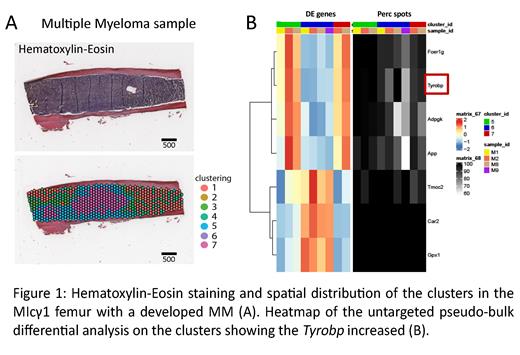Multiple Myeloma (MM) is a malignant plasma cell (PC) disorder characterized by a heterogeneous distribution of PCs in the bone marrow (BM) where the interactions between the PCs and the BM microenvironment guide the pathogenesis of the disease. The development of single cell technologies has contributed to understand the transcriptional heterogeneity of the disease both from the tumor and the microenvironment point of view, yet the spatial organization of cellular states and niche-specific regulatory programs remain to be investigated.
To address the role of spatially resolved interactions in MM, we performed spatial transcriptomic analysis in BM from the MI cγ1mice strain (Larrayoz et al Nat Med. 2023) a recently described mouse model that recapitulates the characteristics of a MYC driven human MM disease using the Visium Spatial Gene Expression analysis (10x Genomics).
Using formalin-fixed paraffin-embedded (FFPE) BM tissues from the femur of control mice, we first characterized the healthy BM. Considering that each spot contains an averaged transcriptomic profile of 3-10 cells, we generated a single-cell reference set that included the most prevalent cell types in the BM to identify the cell type contribution per spot. The relative proportions of the estimations are consistent with percentage estimations observed by previous works (Hongzhe et al, eLife. 2023). Next, using the “cell proportion estimations per spot” we identified four different clusters of spots. A deeper characterization of those clusters revealed a positive correlation between erythroblasts and B cells, and a negative correlation between both cell types and neutrophils. Additionally, we spatially defined clusters 1 and 2, those with larger proportion of erythroblasts, in the metaphysis trabecular regions of the bone marrow. We followed the same analysis framework to characterize the spatial configuration in the MI cγ1 mice BM with a developed MM. To this end, we incorporated the MM-derived single-cell PCs in the single-cell reference set. Importantly, the pathological PCs were identified and organized in large groups in the BM space. Cell proportion estimations in these samples revealed a distribution in 7 clusters, 4 of them concentrated in the periphery of the PC hot spots and 3 mirroring the PC gradient observed in previous analysis (Figure 1A).
We next performed a targeted differential analysis to confirm previous observed markers identities of different MM processes as Cd44 (de Jong et al, Nat Immunol. 2021), a signature of dormant cells (Khoo et al, Blood. 2019), the 38 MM-associated surface-protein-encoding genes (Yao et al, Cancer Res. 2023), Mmp9 and different profiles of T cell exhaustion markers within the 3 clusters with higher PC concentration. These analyses allowed us to verify two different markers, Cd44 and Mmp9 localized in the periphery of the hot spots of PC which may explain an invasive mechanism of the cells localized in the outer areas of the MM combining an inflammatory environment, manifested by a Cd44 increment, with a degradative mechanism driven by Mmp9. Simultaneously, an untargeted differential analysis aimed to identify markers characterizing the clusters with high PC prevalence, revealed novel marker genes never described before in MM and not associated with PC proportion, as the Transmembrane Immune Signaling Adaptor ( Tyrobp) in the cluster 5 (peripheral cluster), which is predictive of a poor prognosis and high tumor immune infiltration in other described tumors (Lu et al BMC Cancer 2021) (Fig 1B).
Finally, as a proof of principle of this technology potential in human samples, spatial transcriptomic was applied to FFPE samples from BM biopsies of 7 MM patients with different degrees of PC infiltration, providing a source for validation of the results obtained in the mouse model.
In conclusion, our findings demonstrate that the application of spatial transcriptomics represents a useful tool for understanding the spatial architecture and niche specific interactions in human diseases, offering a systemic approach to dissect the role of the spatial interactions in the pathogenesis of MM.
Disclosures
Paiva:Roche Glycart AG: Honoraria, Research Funding; Bristol-Myers Squibb: Consultancy, Honoraria, Research Funding; Janssen: Consultancy, Honoraria; Sanofi: Consultancy, Honoraria, Research Funding; EngMab: Research Funding; GSK: Honoraria, Research Funding; Adaptive: Honoraria; Takeda: Honoraria, Research Funding; Amgen: Honoraria; Gilead: Honoraria; Oncopeptides: Honoraria. Martinez-Climent:Roche-Genentech: Research Funding; BMS-Celgene: Research Funding; Janssen: Research Funding; Priothera: Research Funding; Palleon: Research Funding; AstraZeneca: Research Funding.


This feature is available to Subscribers Only
Sign In or Create an Account Close Modal